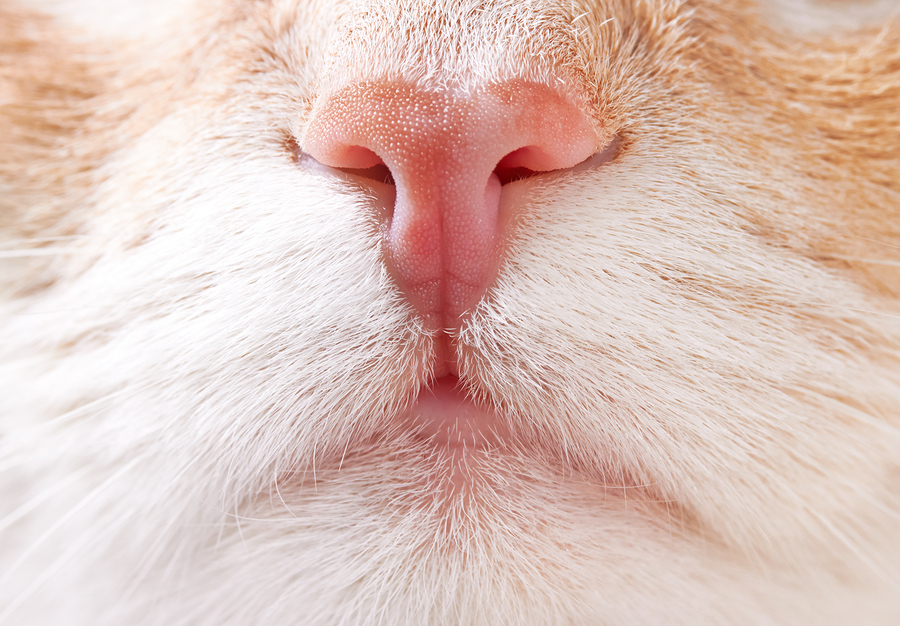Our cats are sensory creatures, but we often overlook their acute sense of smell. Using scent to enrich their environment offers inexpensive, effective, and fun ways to keep your cats happy, stress free, and healthy.
Why Enrichment Matters
An outdoor cat can chase butterflies, climb and claw trees, munch grass and mark territory, stalk critters, and relax in the sun. And if Kitty prefers to be alone, she can chase off or run away from interlopers. Of course, outdoor cats also risk injury and exposure to disease, so most cat lovers in the United States keep pet cats indoors only.
But a restricted indoor lifestyle has negative consequences. Indoor cats must share territory and can’t get away from each other. They exercise less and tend to put on unhealthy weight. Resource sharing strains the relationship even between friendly pets. Dr. Tony Buffington, an expert on cat enrichment, and a principal in the Indoor Pet Initiative, says stressed cats react with sickness behaviors that include hiding, vomiting, refusing to eat, and missing the litter box.
Enriching your cat’s environment gets couch potato cats up and moving, relieves boredom, and helps prevent potential health issues. But let’s look beyond the standard indoor cat tree and window-view bird feeder. Here are some great ways to engage your cat’s nose and increase the fun.
7 Ways to Enrich Cat Environment With Scent
Sometimes we forget that cats’ noses are nearly as sensitive as those of dogs. Don’t overlook scent-rich items that you can’t smell, because they may rock your cat’s world.
That said, cats prone to urine marking may be inspired to spray when they encounter a new scent or detect the presence of strange cats outside their house. Use scent enrichment with caution in these cats. Try one at a time, and mix up the smell-treats over time, to discover what works best for your cats.
Crack Open Windows. Many cats never get a whiff of fresh air, and the smell can be intoxicating fun for them. To ensure they can’t escape, raise the window only a couple of inches to allow the breeze inside. Airborne smells change depending on the weather, so there’s always something new. My cat Karma loves to stand on his hind legs and press his nose to the opening, especially when it rains.
Logs, Sticks, Leaves. Seasoned fireplace logs attract many cats and might serve as a scratch post alternative. My cat enjoys a cedar log, for example, and that smells good to humans, too. For cats who love Christmas trimmings, save a branch from the tree. Or fill a box or paper bag with dry leaves for your cat to sniff and play inside. Pinecones offer aroma, plus something fun to bat around the room. Some cats react to tatarian honeysuckle branches as though to catnip.
Take-Out Treats. Many cats beg for treats when they smell something yummy. Why not give them a sniff-treat once you’re finished, and let them play with the empty paper take-out container? Avoid plastic, and cut handles on paper sacks to prevent them getting caught.
Some cats react to olives like catnip and roll on top of them in ecstasy. And the scent of a melon ball may surprise them, and you, with some sniffing fun.
Flower Power. Cat-safe plants and flowers delight many cats. Roses are edible, so treat your cat to a bouquet now and then (remove the thorns, of course!). Sunflowers, zinnias, snapdragons, and gerbera daisies are safe, as well as oat grass or dandelion. Pluck a handful of greens from the yard and offer to your cat.
Catnip and More. Many herbs we use in cooking are safe and fun for cats to sniff, and some are known to be feline favorites. Catnip, part of the mint family, affects many cats with a scent-induced kitty “high.” Silver vine has a similar effect. And valerian can energize cats. Fresh work best, but even the dried form may inspire kitty love.
Herbal Love. Other safe herbs cats may enjoy sniffing include dill, oregano, parsley, and rosemary. Sprinkle herbs on a carpet or towel for your cat to enjoy. Try filling a plastic bag with catnip, drop in your cat’s favorite toy mice for a few days, and then offer the refreshed toys.
Essential Oils—Be Cautious! While popular for people, essential oils can be dangerous for cats as they metabolize them differently. It is not recommended to apply essential oils to cats for this reason, but their scents can be beneficial. Lavender, which has natural sedative properties, may help soothe an anxious cat. Copaiba, helichrysum, and frankincense are also considered safe for cats. Before using essential oils, even in the form of diffused scents, around your cats, check with your holistic veterinarian for recommendations.
Using scent environmentally can help reduce potential fear and stress in your cat. That not only helps your cat, it enriches the bond you share.
This article was reviewed/edited by board-certified veterinary behaviorist Dr. Kenneth Martin and/or veterinary technician specialist in behavior Debbie Martin, LVT.








